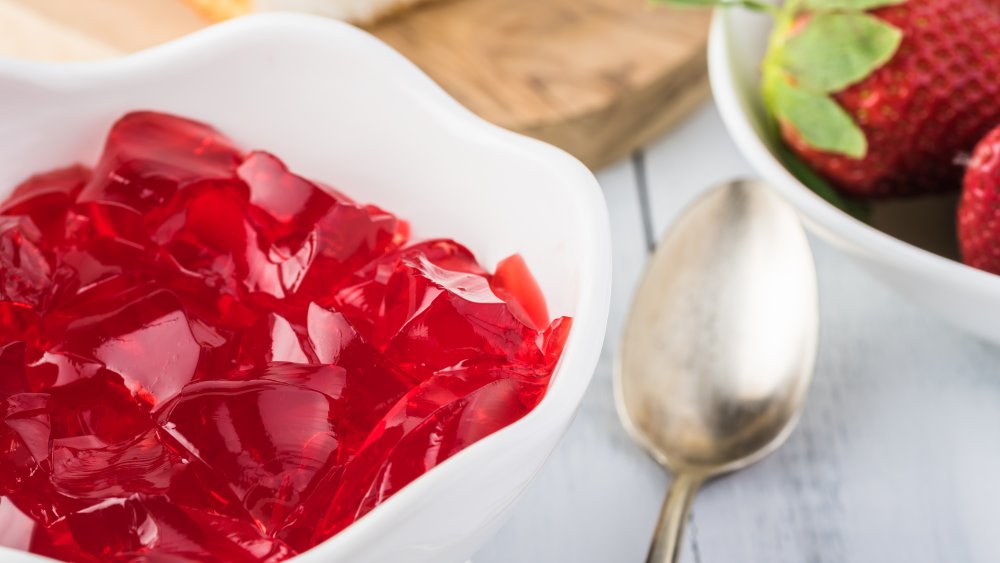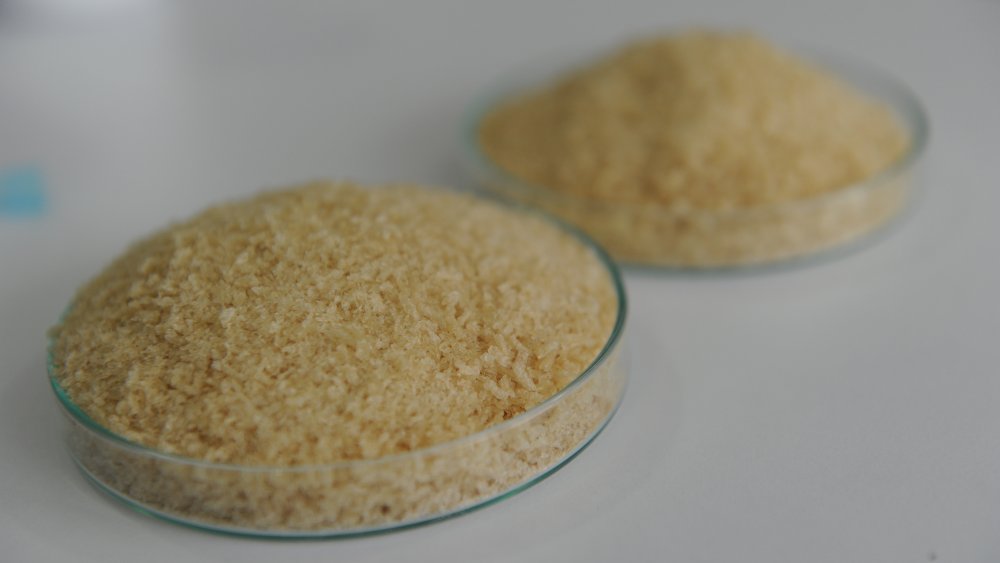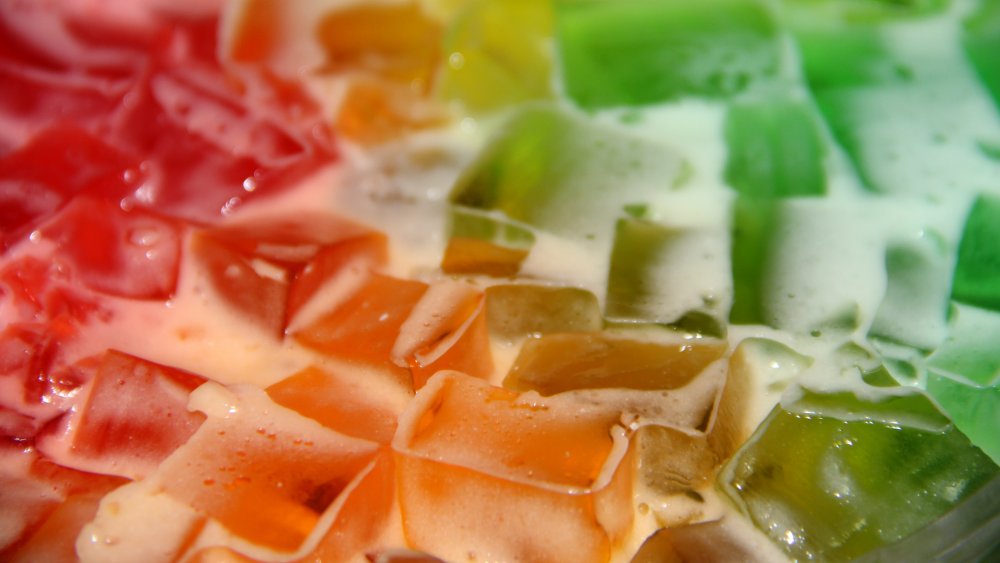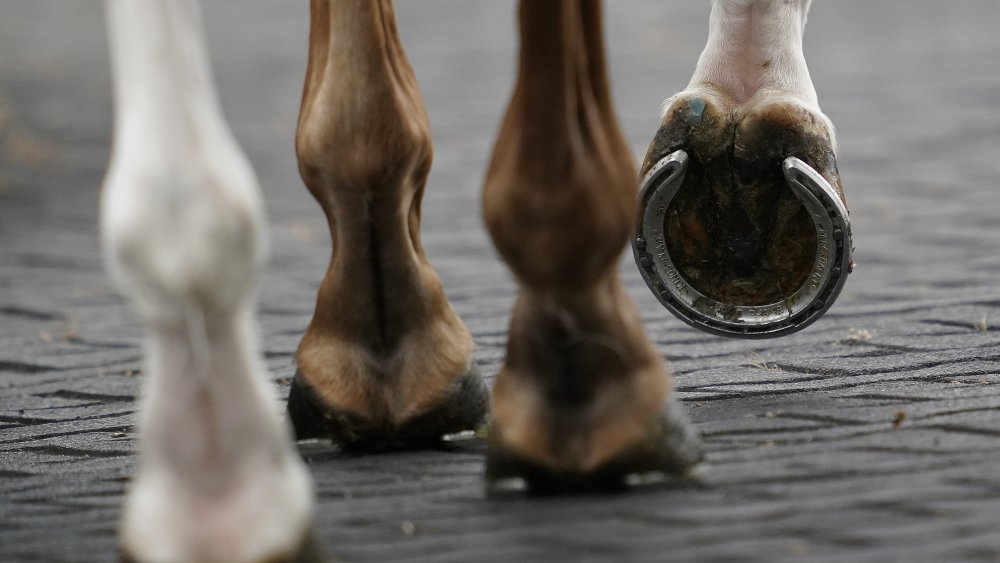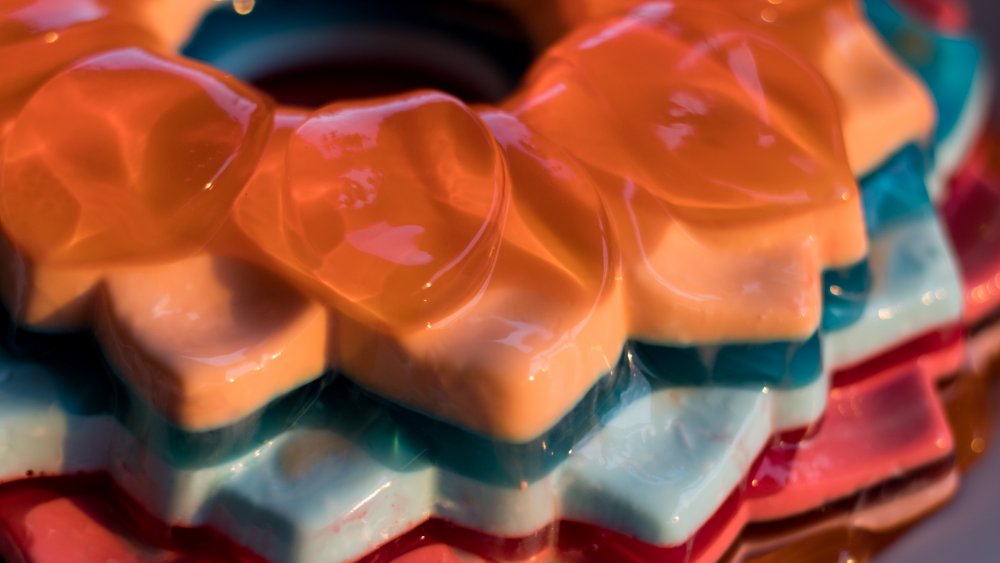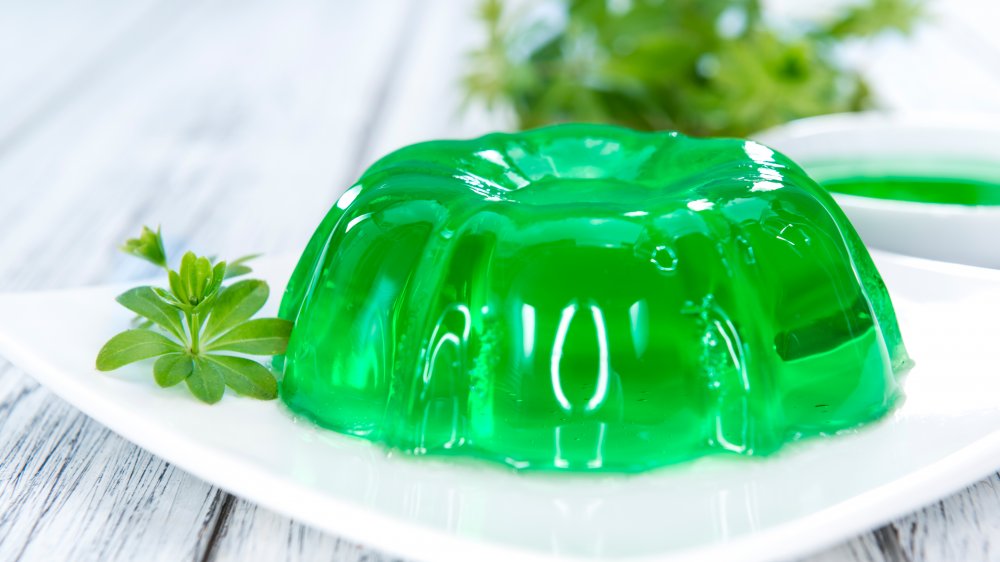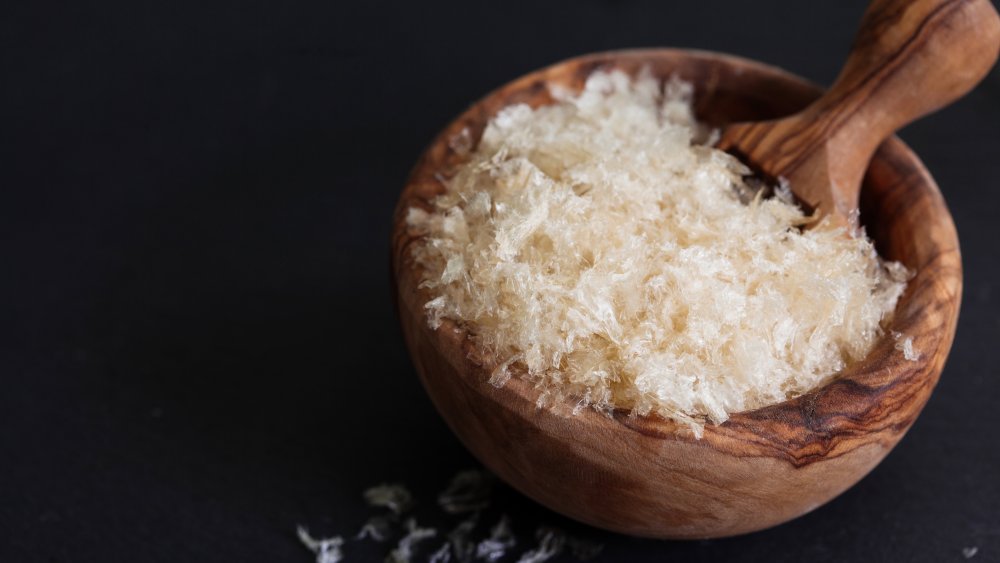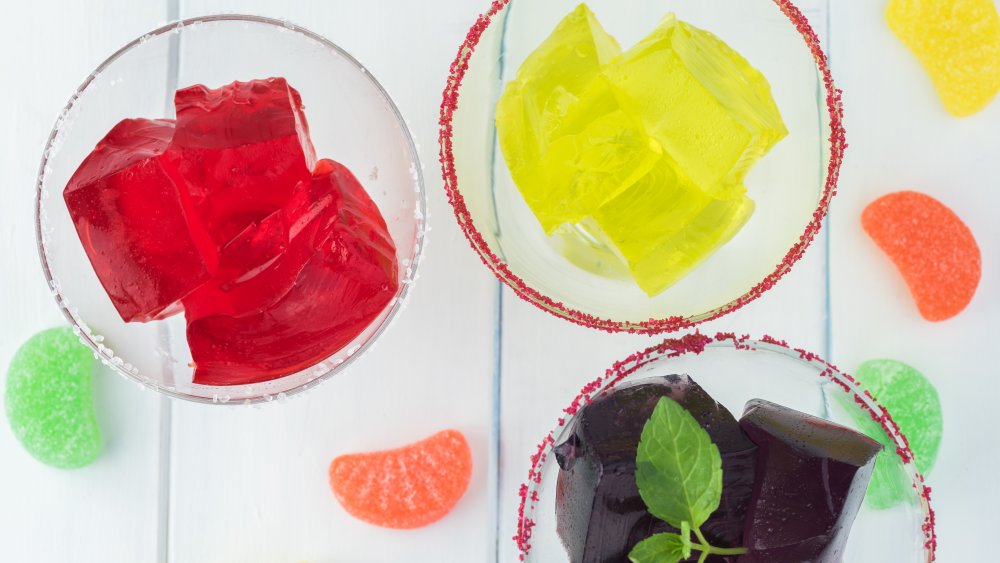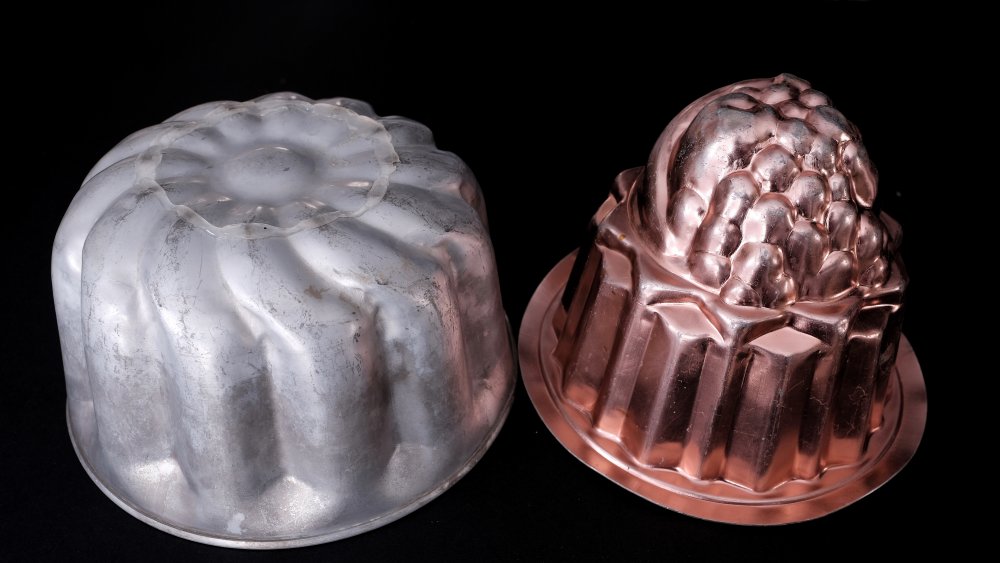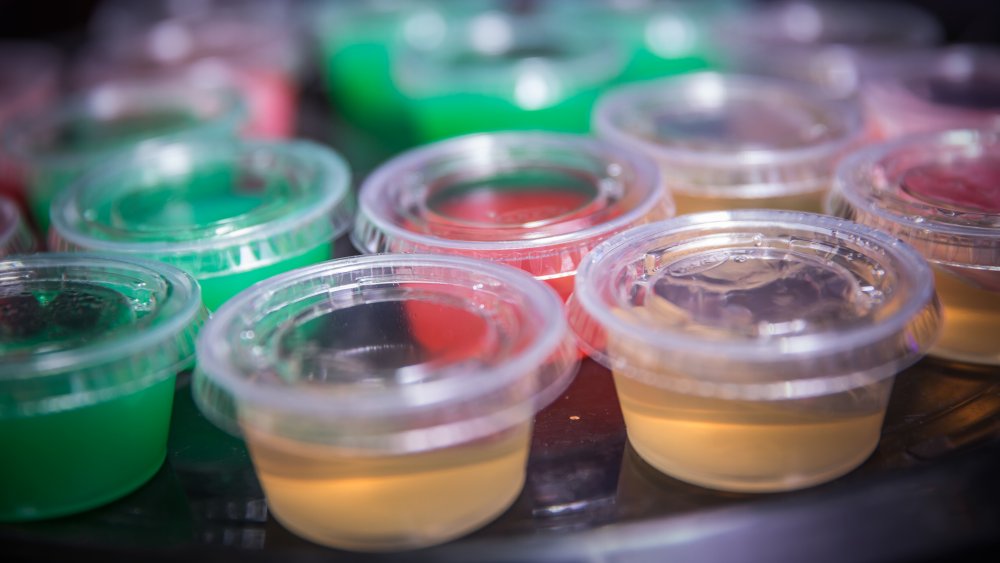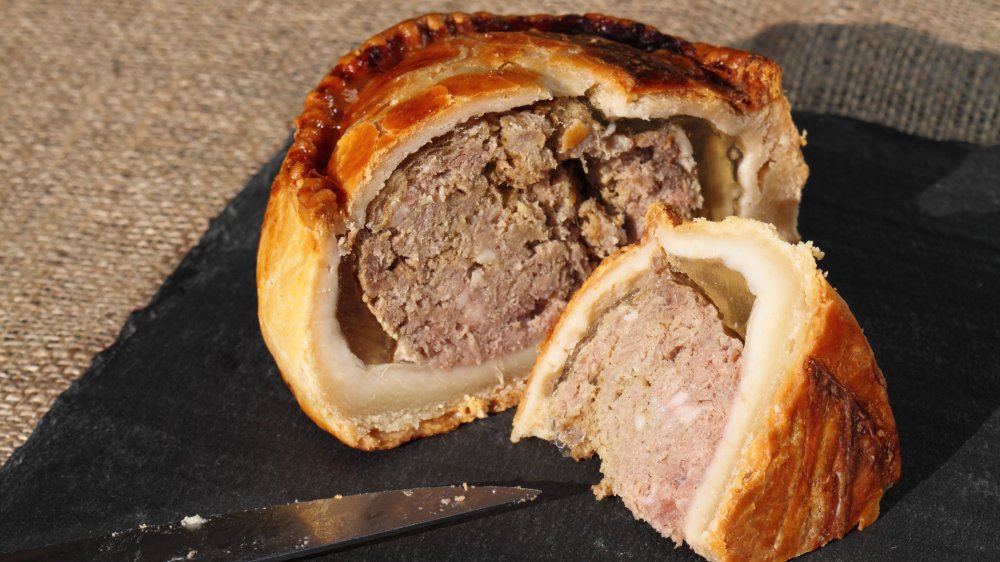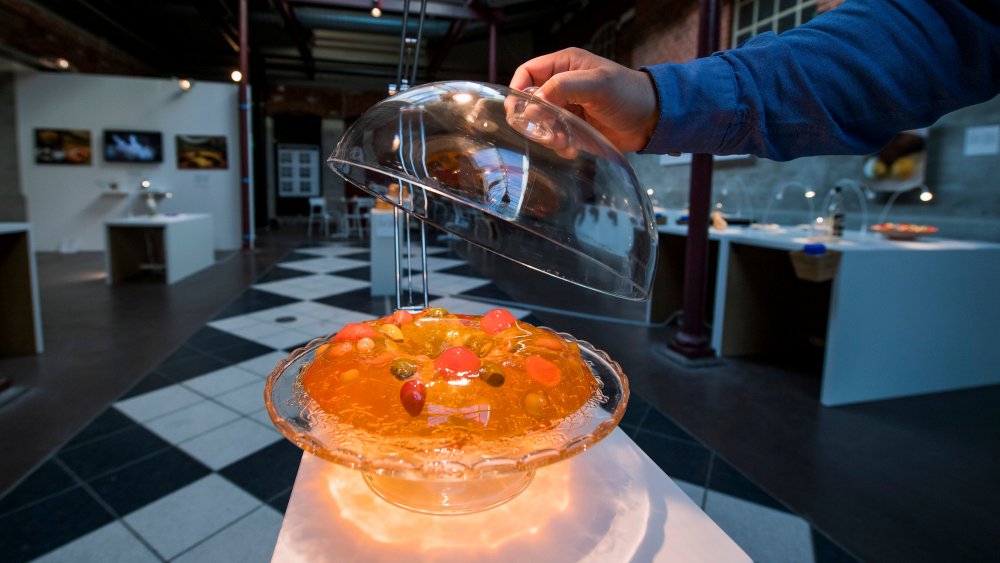This Is How Jell-O Is Really Made
Jell-O is practically an American institution. Since its invention almost 150 years ago, this popular jellied treat has gone on to become one of the country's most beloved desserts — partially thanks to its affordability, but mostly thanks to its sheer versatility. That's because Jell-O can go with pretty much anything: it can be used in trifles, pies, cakes, mousses, punches, cookies, salads, and even drinks. Need to spruce up a dessert? Just add Jell-O. Want to rustle up a quick, easy yet pretty snack for the kids? Make Jell-O. Going through a particularly bad break-up and feel like ingesting your body weight in sugar? Jell-O is where it's at.
So just how is it made? Obviously, we all know how it's prepared — you dissolve it in water, chill it and allow it to set. But what is Jell-O made from? Who invented it? Is it bad for you? And does it really contain horses' hooves? Well, we've got you covered. From its long-reaching history to its key ingredients, to its many uses in the kitchen, this is how Jell-O is really made.
Jell-O start with gelatin... but what is that?
The key ingredient in Jell-O — the thing that really makes it what it is — is gelatin. Of course, you've probably heard of this stuff before, and you might have heard some pretty gruesome rumors about it, too. So what is it?
Put short: it's a flavorless, colorless ingredient derived from animal collagen. Gelatin occurs naturally in the meat, bones, and cartilage of various animals, and is the reason that meaty soups or broths begin to solidify after they're chilled for long enough. Generally, the collagens from which gelatin is derived comes from an animal's skin, tendons, ligaments, and bones. This is why many people — including vegans and members of certain religions — are unable to eat Jell-O and other foods that include gelatin (like marshmallows).
During the manufacturing process, these connective tissues are boiled, dried, treated with acid, and filtered out in order to extract the collagen. This is then dried and ground up into a powder. This powder can be added to liquids to give them the jiggly characteristic for which Jell-O is so well-known — but only if it's done right.
The science works like this. When you dissolve powdered gelatin in cold water, the granule gelatins become hydrated. When you add that mixture to a warm liquid, the collagen molecules begin to stretch and loosen. Then, when you put the mixture into the fridge, those fully-hydrated gelatin molecules rebond, turning the liquid into Jell-O. Just like magic, ain't it?
What else is in Jell-O?
Of course, Jell-O includes a few other ingredients besides gelatin. One of the key ingredients in Jell-O is sweetener: usually aspartame, a type of artificial, calorie-free sweetener, but also sometimes sugar. Jell-O also contains artificial flavors — how else do you think they get it tasting so good?
Then you've got your food colorings. These days Jell-O has a few products made from natural ingredients. Most types of Jell-O, however, are still made with artificial food dyes. Put all this together and you've got a surprisingly hefty ingredient list.
Take Strawberry Jell-O, for example. This kind of Jell-O contains not just gelatin, but also sugar, adipic acid, artificial flavor, disodium phosphate, sodium citrate, fumaric acid, and red dye #40. Meanwhile, sugar-free Black Cherry Jell-O contains those same ingredients, only with aspartame instead of sugar, and a slightly different dye (maltodextrin and blue dye #1). Although you can assume most Jell-Os contain the same basic ingredients, the only way to find out the specifics is by checking the label.
Does Jell-O contain horse hooves?
It's a relatively common rumor, albeit one that seems to have declined a little since the advent of the internet age. We've all heard it, though: Jell-O contains horses' hooves. But is it true?
In a word? Nope. The root of this rumor is obvious, of course. Gelatin is made from collagen, and that's derived from connective tissues in animal meats, meaning you would be right to say that Jell-O contains the bones and skin of animals. You know that already though, don't you? What's crucial to know here is that, first of all, gelatin doesn't tend to be made from horse — usually, it's the connective tissue of cows and pigs that are used in the manufacturing process. Presumably, this is because cows and pigs are far more regularly farmed and slaughtered than horses, so their skin and bones are far easier to get hold of.
But that's not the only reason the "horses' hooves" rumor doesn't hold up. There's also the fact that the hoof of an animal doesn't actually contain gelatin at all. Instead, the hoof is made from keratin, another kind of protein that can also be found in turtle shells and human fingernails. This protein can be used to similar effect as gelatin — in fact, it's commonly used in the production of glue — but trust us, you won't find it in your Jell-O.
Is Jell-O good for you?
You wouldn't imagine many people consider Jell-O to be a particularly healthy food, and it's safe to say that there's no surprise in store here. It's not.
While Jell-O is low in calories and fat-free, that doesn't make it good for you. One serving of Jell-O tends to contain around 80 calories, 1.6 grams of protein, and 18 grams of sugar. Even the sugar-free variants aren't great. One serving of sugar-free Jell-O usually contains 13 calories, 1 gram of protein and no sugar; but artificial sweeteners can still have adverse effects on your health.
Beyond the sugar content, however, it's important to realize that Jell-O contains practically zero nutrients. That means you're not getting any vitamins or minerals out of it. Considering it's also low in protein and fiber, it's hard to make much of an argument for Jell-O as a health food. Nutrition-wise, this stuff is basically just sugar with a dash of protein.
Soylent Jell-O is made of people
Now, there's literally zero chance you've gotten this far and not wondered whether Jell-O can be made from humans. And good news! It sure can.
In 2011, Popular Science reported that scientists are developing a "new approach" for producing gelatin derived from humans, in large enough quantities to be able to replace the animal-based gelatins currently used in the food, pharmaceutical, and cosmetic industries. To create this kind of gelatin, "human genes are inserted into yeast strains that are tuned to produce gelatin in specific, controlled ways."
Obviously, there's an environmental aspect to this, but that wasn't the only reason this research began. Because gelatin is derived from animals, it actually has a very slight risk of provoking immune symptom responses in humans, or carrying infectious diseases. These scientists believe these problems — as well as some other quality issues that animal gelatin often comes with — might actually be solved by creating gelatin from humans.
But this new kind of gelatin also throws up an interesting conundrum: is it vegetarian? Or is it actually a very weird kind of ethical cannibalism? Although human gelatin hasn't quite reached the commercial phase of its development, you may yet see it hit stores in the coming years. The question is — would you try it?
There are vegan Jell-O options
If you're a Jell-O fan who'd rather not eat something that's made from pig ears, cow tendons, or human genes, you might be on the lookout for vegan gelatin. Luckily, there are plenty of options out there.
A number of different ingredients can be used to make vegan gelatin. The first is agar-agar. Like gelatin, this seaweed extract is flavorless, odorless, and colorless, and handily comes in a powdered form. It's this kind of agar-agar that can be substituted for gelatin on a 1:1 ratio. (Agar-agar flakes and bars are different; one tablespoon of flakes or half a bar should be used for one cup of liquid.) All you need to do is dissolve the agar in the liquid — blend it if necessary — before allowing the mixture to set at room temperature for about an hour.
Then there's pectin, which is made from fruit skins and rinds, and is most commonly used to thicken jams, jellies and marmalades. To get it to gel properly, you'll need to add some sugar. Add five cups of sugar to each pack of powdered pectin, or three to four cups to each pouch of liquid pectin. Throw in a little lemon juice for acidity and you've got your gelatin substitute ready to go.
You could also try carrageenan or vegetable gums. Just be aware that these come with their own issues: carrageenan has been linked to gastrointestinal problems, while some people find it difficult to digest certain vegetable gums.
Jell-O has had some weird flavors
One of the best things about Jell-O is that it can come in pretty much any flavor — and when we say any flavor, we mean any flavor. Some of the most popular Jell-O flavors to have hit stores over the years include strawberry, orange, cherry, watermelon, and mango. Occasionally, mainstream Jell-O desserts have pushed the boat out a little further, with flavors such as fruit punch, berry blue, tropical fusion, and apricot. But they're not that weird, are they?
Well, over the years, Jell-O has introduced and discontinued a range of seriously weird flavors, too. There's celery, for one, if you're the kind of person who prefers their Jell-O salty and watery. Or how about Italian salad, for when you just have to jelly your leftover tomatoes and mozzarella. Even more palatable varieties, such as mixed vegetable and seasoned tomato (okay, when we said "palatable"...) have sadly been cut from the Jell-O roster.
Some of the weirder sweet flavors of Jell-O have included bubble gum, chocolate, and coffee — just in case you need any reminding just how far we've come since those original jellied meats in the 15th century. Jell-O also made cola, cotton candy, maple syrup, and sparkling mandarin orange Jell-Os. Because why not?
A brief history of Jell-O salads
One of the truly iconic uses for Jell-O — albeit one that isn't quite so popular as it once was — is the Jell-O salad. According to author Laura Shapiro, during the early 20th century "nothing so quickly identified a meal as upscale, glamorous and artistic as a magnificent salad." The invention of Jell-O and its rising popularity in America gave homemakers the opportunity to showcase their magnificent, fancy salads in an even more exciting way.
These jellied salads become so popular because "there was nothing remotely salad-like about them," says Shapiro. "You ate dessert and called it salad... it was supremely sweet, which was the goal of an enormous amount of American cooking and eating."
By the mid-70s, it was practically impossible to attend an American dinner party, picnic, or potluck that didn't feature at least one Jell-O salad. Unfortunately, not all of them were tasty. "Savoury Jell-O salad," says food writer Wendy Tien, "led me to perfect the art of pretending to take a hearty bite and disposing of it in a napkin."
But they're not completely gone. In fact, some people, like chef Junji Umezu, still make them at home. Just before Thanksgiving 2013, he told The Guardian he'd be making an "olive, celery and sweet pepper in a lemon juice-spiked gelatine mix." He continued, "We have it for Thanksgiving every year. Personally, I dig it — good texture and flavour — but I grew up with it. My wife, on the other hand, thinks it's disgusting."
There are many way to make Jell-O shots
Ah, Jell-O shots. The backbone of partying in the western world. The bane of many a college freshman. The gelatinous, delicious concoction that can only be described as simultaneously one of the best and worst ideas ever devised by mankind.
One of the biggest problems people tend to have with Jell-O shots is that they get drunk off them way too fast. That's because when you ingest alcohol in a solid form, it doesn't dissolve on your tongue quite as much as a liquid might, meaning you taste it less. Obviously, that means trouble. According to Serious Eats, a standard Jell-O shot recipe will usually call for 5 ounces of 80-proof vodka and 11 ounces of water. Unfortunately, this standard shot will end up tasting watered down; but a stronger shot might cause you a whole new world of bother. So how do you get them just right?
Playing with texture can help. Using xanthan gum as a thickener rather than gelatin can often create a jellified outer coat and a liquid interior, giving you what essentially amounts to a small booze grenade that bursts open when you bite into it. You could also use corn syrup and egg white to give your alcoholic jellies a puffier texture.
You could also try some new flavors by utilizing in other alcohols and add-ins. Vodka in a strawberry Jell-O shot is one thing, but how about Cosmopolitan Jell-O shots? Guinness Jell-O shots? Mojito Jell-O shots? The sky's the limit — just don't try them all at once.
Gelatin has a long history before Jell-O
Gelatin-like substances have been mentioned in historical records that date back as far as the Roman era, but gelatin as we know it shows up during the early 15th century. During this period, medieval cooks used the gelatin made from broths of boiled pigs' ears and feet to make "jellies."
These jellies were enjoyed both for their strange texture and their ability to prevent spoilage of any meats and vegetables that were encased within them. (This technique is still used in certain places today, in dishes such as traditional English pork pies.) When the Catholic Church later recommended their followers not consume meat on Fridays, medieval chefs developed fish jellies to cope — usually made from eels.
At the end of the medieval era, however, sweet jellies were finally created; although many derived their texture from ingredients such as pectin — which comes from fruits — rather than gelatin. In 1818, gelatin was manufactured industrially for the first time. By the mid-1800s, the first gelatin dessert mix had been patented, by a New York industrialist and glue magnate named Peter Cooper. His powdered gelatin mix was made using processed lemons, sugar, eggs, and spices.
Unfortunately for Cooper, his invention was eventually overshadowed by someone else's. In 1887, Pearle B. Wait created his own mix of gelatin, sugar and food coloring. At his wife's suggestion, he named it Jell-O.
The Jell-O Company
In 1899, Pearle Wait sold his formula and patent for Jello-O for $450 (around $12,000 in today's money) to a businessman named Frank Woodward. Unfortunately, Jell-O didn't exactly take off. Despite an aggressive marketing campaign — which involved widely distributing free Jell-O samples and recipes to grocery stores — sales lagged. Frustrated by his lack of success, Woodward offered the rights to Jell-O to the superintendent at his production plant — for $35; that's around $1,000 today.
Luckily, the superintendent refused, and in 1904, things turned around for Woodward. Using the money he had made from other products, he bought ads for Jell-O in Ladies Home Journal, a nationally-syndicated publication. Sales of Jell-O soared, and in just a few years it had become one of America's most recognizable brands; free Jell-O molds were even handed out free to immigrants arriving at Ellis Island. Woodward didn't get to enjoy much of the success — he passed away in 1906.
By 1924, Woodward's company (once the Genesee Pure Foods Company) had become the Jell-O Company. Over the next century, the product got stronger and stronger, thanks in large to the Jell-O Company's admirable marketing skills. Catchy jingles, ingenious slogans, celebrity spokespeople, and the iconic Jell-O Girl all helped to sell the product to America.
In 1964, an industrial conglomerate known as General Foods — today known as Kraft — took over the manufacturing of Jell-O's product.
